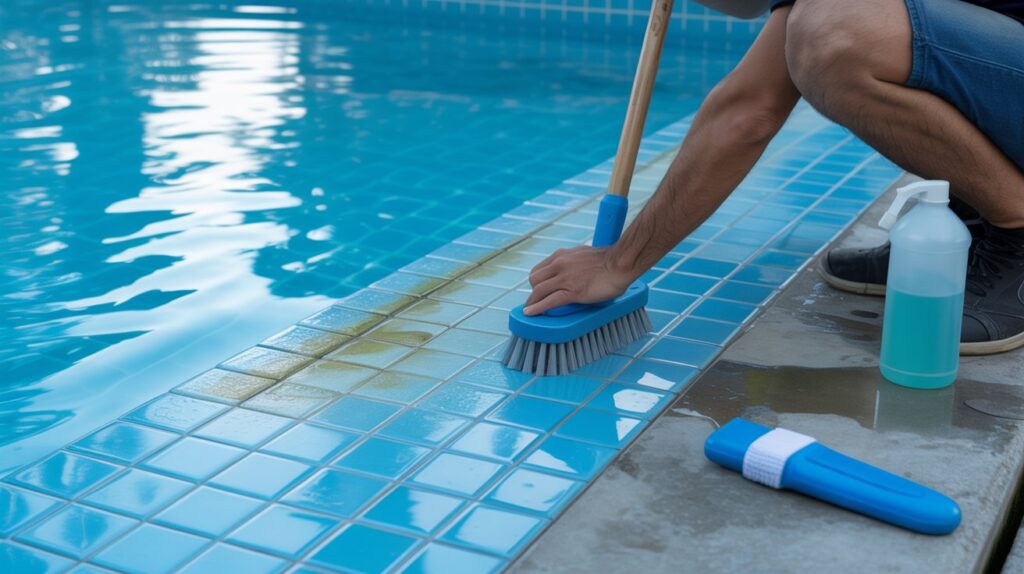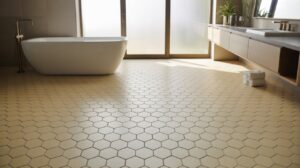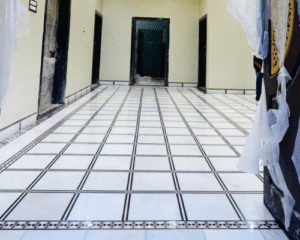How to Clean Swimming Pool Tiles: A Complete Professional Guide
Cleaning swimming pool tiles is an important part of maintaining a fresh, healthy, and inviting pool. Over time, tile surfaces collect mineral deposits, dirt, sunscreen residue, and algae that can take away the shine of your pool. In this guide, you will learn how to clean swimming pool tiles and maintain clean tiles throughout the year.
This article also explores cleaning glass tiles in a swimming pool, maintaining grout between tiles, caring for mosaic tile surfaces, and treating tiles above the waterline. By the end, you will have a complete understanding of the tools, techniques, and natural or professional cleaning solutions needed to keep your pool tiles spotless, polished, and long-lasting.
What You Will Need To Clean Swimming Pool Tiles
Equipment and Tools
You may need items such as a pool vacuum, skimmer net, soft and stiff brushes, protective gloves, a bucket, a pumice stone, microfiber cloths, and eye protection. These tools help remove loose dirt, skim floating debris, and scrub away hard buildup without damaging the tile.
Materials
Useful cleaning materials include baking soda, dishwashing liquid, melamine sponges, tile cleaning products, vinegar, soda blasting solutions, hydrogen peroxide, and mild acids. Always choose products that are safe for your specific tile type, especially when cleaning glass or mosaic surfaces.
Why Pool Tile Cleaning Matters
Pool tiles stay in constant contact with water that contains minerals, chemicals, oils, and organic particles. When water evaporates, minerals settle on the tile surface and form hard deposits. Without regular cleaning, these deposits can discolor the tiles and make the waterline look dull.
Dirty tiles can also develop algae and bacteria. This not only affects the beauty of your pool but can also create slippery surfaces. Regular tile maintenance prevents damage, preserves the appearance of your pool, and reduces long-term repair costs.
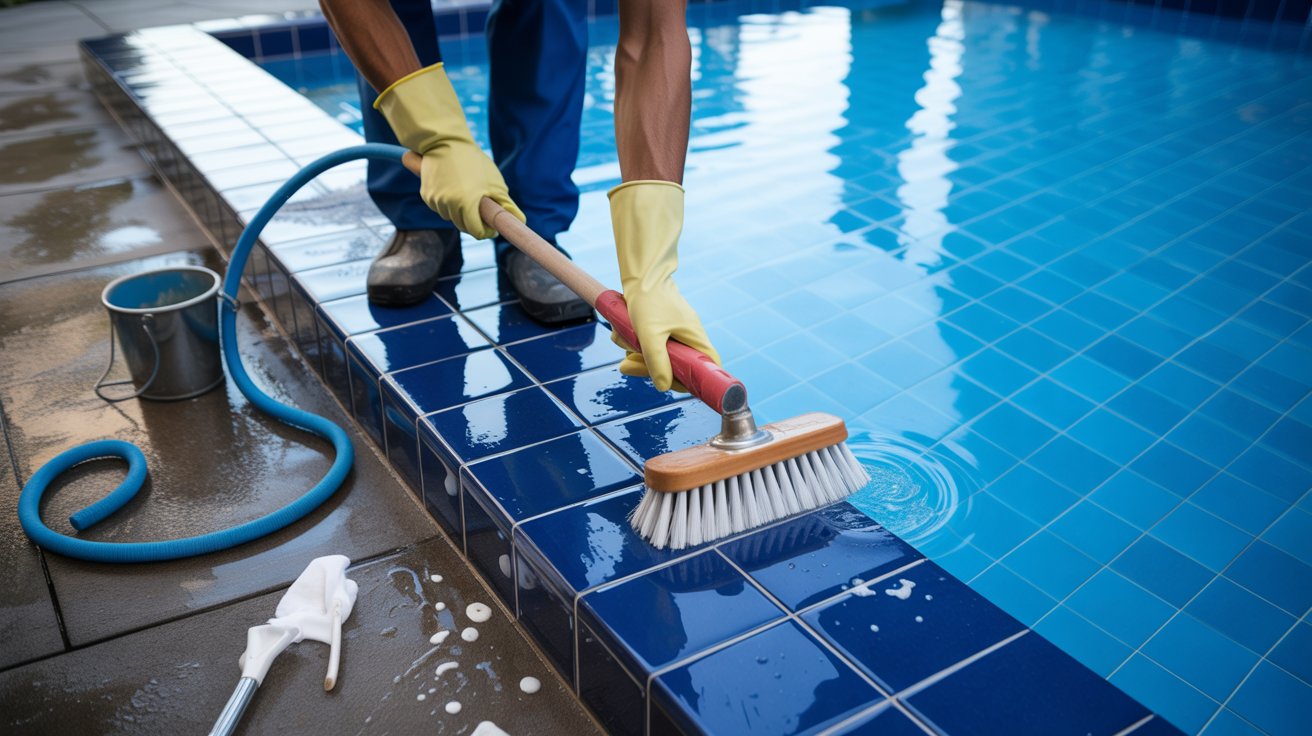
Types of Pool Tile Buildups and What Causes Them
Pool tiles can develop different types of buildup. Mineral deposits, body oils, algae growth, and general dirt can gather around the waterline. Hard water rich in calcium and magnesium often creates a white or gray scale. Sunscreens, lotions, and organic matter add a sticky film that traps dust and grime.
If the tile grout remains wet for long periods, it may darken or stain. Mosaic tiles and glass tiles show marks more quickly because their smooth surfaces highlight residue. Understanding the cause helps you choose the correct cleaning method.
How Often Should You Clean Pool Tiles
Cleaning frequency depends on pool usage, water quality, and climate. Light cleaning should be done weekly or at least monthly. Waterline tiles should always be cleaned whenever discoloration appears. At a minimum, clean tiles before and after every pool season.
Regular cleaning prevents heavy buildup, making every cleaning session easier and reducing the need for strong chemicals.
How to clean pool tiles above the water line
Cleaning swimming pool tiles at the waterline is essential because this area collects the most dirt, oils, and calcium deposits. Lower the water level slightly, apply a mild cleaning solution, and scrub with a soft or medium brush. Rinse thoroughly to reveal clean, bright, and smooth tiles.
Run Your Pool Cleaner
Begin the process by running your pool vacuum. This removes loose dirt and prevents it from settling back on the tiles while you clean. Removing floating debris first results in a smoother cleaning session.
Remove Debris With a Skimmer Net
Use a skimmer net to collect leaves, grass, insects, and any organic matter. Keeping the water surface clean reduces the amount of grime that sticks to the tile.
Drop the Water Level
Lower the waterline slightly so that the tiles are fully exposed. You may use a pump or a simple siphon. A lower waterline gives you better access to stains and buildup.
Use a Scrub Brush on the Tiles
For ceramic or porcelain tiles, use a stiff nylon brush. For glass tiles, use a soft brush to avoid scratches. Scrub in small sections, using gentle circular motions.
Mix the Cleaning Solution
Create a cleaning solution that fits the tile condition. Baking soda mixed with water forms a soft paste for mild stains. Dishwashing liquid and water work well for sunscreen residue. Always wear eye protection.
Remove Dirt and Grime
Apply your cleaning solution using a brush or melamine sponge. Scrub until the mineral deposits and body oils begin to dissolve. Rinse with fresh water and repeat around the pool perimeter.
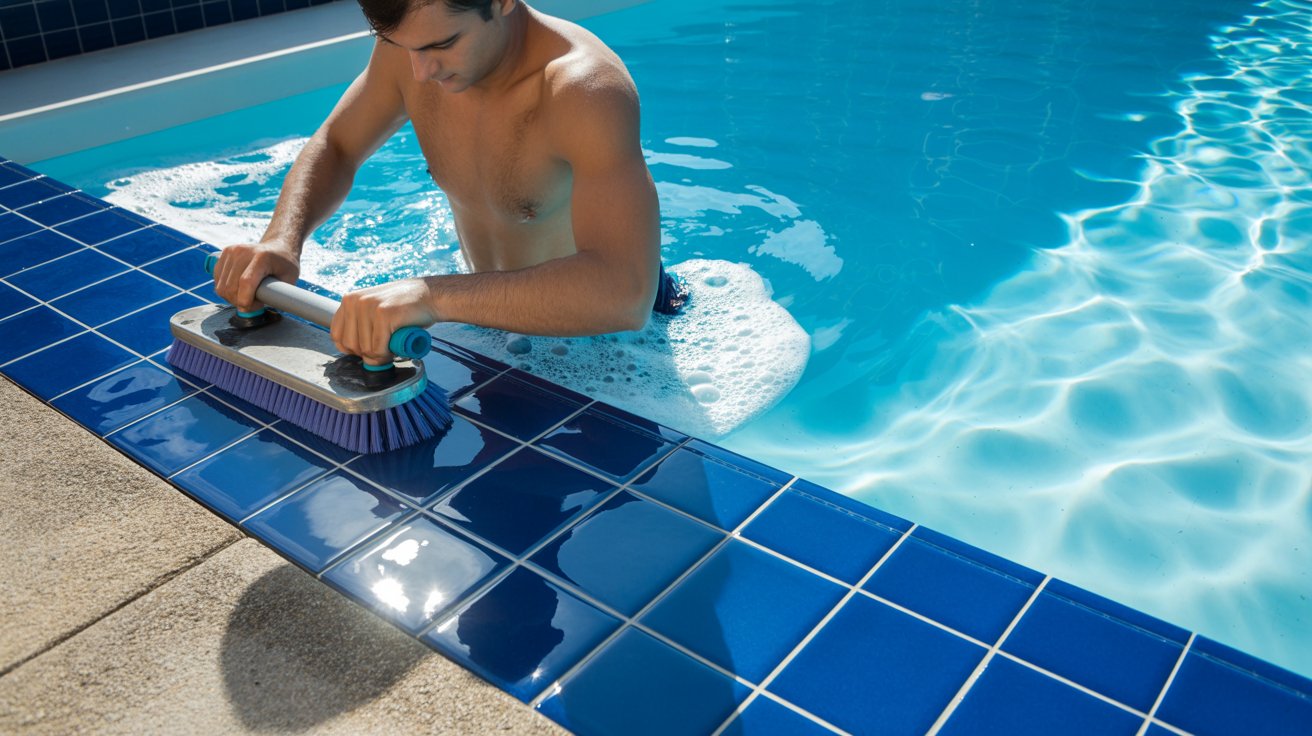
How to Clean Calcium From Swimming Pool Tiles
Removing calcium from swimming pool tiles requires a careful approach because calcium forms stubborn white or chalky deposits along the surface. Start by lowering the waterline and applying a gentle descaling solution or a mixture of vinegar and water. Scrub the area with a soft or medium-bristled brush until the deposits loosen. Rinse well and repeat for heavier buildup.
Use a Pool Tile Cleaning Solution
Special tile cleaning products dissolve calcium scale. Apply the product according to the instructions and gently scrub the surface.
Avoid Harsh Chemicals
Strong acids may damage grout or delicate tiles. Always start with mild solutions before moving to stronger options.
Create a DIY Acid Cleaner
Muriatic acid mixed with water can help remove stubborn scale. Always add acid to water slowly. Wear gloves and goggles, and use this method only when mild cleaners fail.
Scrub With a Soft Brush
Use a soft or medium-bristle brush for gentle scrubbing. This protects glass tiles and mosaic surfaces.
Avoid Using Pumice Stones on Delicate Tiles
A pumice stone removes calcium effectively but may scratch glass or patterned mosaic tiles. Always test it on a small area first.
Remove Leaves and Organic Debris
Keeping the pool clean reduces the amount of organic matter that sticks to calcium and forms tough stains.
How to clean stained swimming pool tiles
Stains appear when algae, oils, metals, or chemical imbalances settle on the tile surface. Light stains can be managed with gentle cleaners, while deeper stains require stronger solutions. The goal is to lift the discoloration without harming the tile finish. With regular care, stains become easier to manage each season.
Steps to clean stained pool tiles
- Lower the waterline slightly for better access.
- Apply a baking soda paste, vinegar mix, or use a melamine sponge for mild stains.
- For deeper stains, apply hydrogen peroxide or a specialized stain remover.
- If stains remain, professionals may use soda blasting for safe and effective removal.
How to Clean Glass Tile in a Swimming Pool
Glass tiles add beauty but must be cleaned gently to avoid scratches. They collect oils, sunscreen, and calcium deposits easily. Mild cleaners remove buildup without clouding the glass. After cleaning, proper rinsing ensures a bright, reflective finish.
Steps to clean glass pool tiles
- Use a soft brush to avoid scratching the surface.
- Mix baking soda and water into a mild cleaning paste.
- Apply vinegar and water to dissolve light scale.
- Rinse with fresh water and wipe with a microfiber cloth for a clear shine.
How to Clean Swimming Pool Tile Grout
Grout absorbs dirt faster than tile because of its porous texture. Oils, minerals, and algae settle into grooves and create discoloration. Gentle cleaners restore the grout without weakening its structure. Avoid strong acids because they harm grout over time.
Steps to clean pool tile grout
- Mix baking soda and water into a thick paste.
- Apply the paste to grout lines and scrub with a small brush.
- Use hydrogen peroxide for deep or stubborn stains.
- Rinse thoroughly to maintain the pool’s chemical balance.
How to Clean Mosaic Tiles in Swimming Pool Settings
Mosaic tiles combine materials like glass, ceramic, and stone, so they require gentle care. Harsh scrubbing or chemicals may damage certain pieces. Mild cleaners remove buildup safely. Only strong solutions should be used when lighter options fail.
Steps to clean mosaic pool tiles
- Use a soft brush to protect delicate surfaces.
- Apply mild cleaners such as baking soda paste or diluted soap.
- Eat calcium buildup with a vinegar solution first.
- Use muriatic acid only when necessary and apply it very carefully.
How to Clean Pool Tiles Above the Water Line
The area above the waterline collects oils, dust, sunscreen, and calcium deposits. This section stains more quickly because it dries in the sun. Cleaning it regularly keeps the pool looking fresh. A gentle approach prevents surface damage.
Steps to clean pool tiles above the waterline
- Lower the water slightly for easier access.
- Apply a cleaning solution using a sponge or soft brush.
- Scrub gently to remove dirt, oils, and scale.
- Use a melamine sponge for stubborn marks and rinse thoroughly.

How to Get Rid of Tough Pool Stains
When stains remain after regular cleaning, stronger tools may be required. Mineral deposits and years of buildup can harden on the tile surface. Using the right method prevents damage and restores the tile’s appearance. Patience and proper technique make a big difference.
Use a pumice stone
- Choose only a pool-safe pumice stone.
- Keep both the stone and tile wet to avoid scratches.
- Rub gently in small circles to break away deposits.
- Rinse the area thoroughly after use.
Try a commercial cleaner
- Select a cleaner that contains sulfamic acid for tough buildup.
- Apply according to the manufacturer’s instructions.
- Avoid using these products after adding pool chemicals.
- Rinse well and allow several days before swimming.
Types of Pool Cleaning Brushes for Tile
When learning how to clean swimming pool tiles, using the right brush is essential for effective results. Pool tile brushes come in different bristle strengths depending on the tile material and the level of buildup. Soft-bristle brushes are ideal for delicate surfaces like glass tiles, preventing scratches while still cleaning effectively. Medium-bristle brushes work best for ceramic or porcelain tiles, offering stronger scrubbing power.
For stubborn calcium deposits or heavy grime, stiff nylon brushes help remove buildup without damaging the surface. Avoid wire brushes completely, as they can scratch tiles, harm grout, and reduce the lifespan of your pool surfaces. Choosing the right brush makes pool tile cleaning easier and safer.
Natural Cleaning Solutions for Pool Tiles and Grout
Natural cleaning solutions are a safe and effective way to maintain pool tiles and grout. Mixtures like vinegar and water dissolve light scale, while baking soda paste helps remove stains without damaging surfaces. Lemon juice also works as a gentle acidic cleaner. These eco-friendly options protect tile surfaces and keep grout looking fresh.
- Lemon Juice: Lemon juice contains natural acids that help lighten stains.
- Hydrogen Peroxide: Hydrogen peroxide is excellent for organic stains.
- Baking Soda and Vinegar Paste: This paste removes grime gently.
- White Vinegar Solution: Vinegar dissolves light calcium scale.
Regular Cleaning Practices for Easier Maintenance
Keeping your pool tiles clean becomes much easier when you follow a consistent maintenance routine. Brushing the tiles and walls every week helps prevent algae growth and stops calcium deposits from forming. Skimming leaves and surface debris daily also reduces organic buildup, keeping the pool looking clear and inviting.
Maintaining balanced pool chemistry is equally important for reducing stains and scale. Ensure proper pH, alkalinity, and calcium hardness levels so minerals do not stick to the tile surface. Also, make sure your pool pump runs for enough hours each day to allow proper circulation. Good circulation prevents stagnant water, algae growth, and future tile cleaning problems.
Algae and Bacteria Prevention
Preventing algae and bacteria requires careful attention to water chemistry and cleanliness. Proper chlorine levels, balanced pH, and regular monitoring of calcium hardness keep the water healthy and inhibit microbial growth. Regular brushing of tiles and grout lines also removes potential algae spores before they take hold.
Good circulation is equally important for preventing stagnant areas where bacteria and algae thrive. Ensure your pool pump and filtration system operate efficiently, and treat your pool promptly if any green tint or slimy texture appears. Maintaining these practices consistently ensures a safe, sparkling, and algae-free swimming environment.
Pro Tips to Keep Tile Buildup Away
Preventing tile buildup is easier than removing it after it forms. Maintaining stable pH and calcium hardness levels ensures minerals do not accumulate on the tiles. Regularly check and adjust your pool chemistry to avoid scale formation and discoloration. Consistent water balance protects both tiles and grout from long-term damage.
Address small scum or stains as soon as they appear. Using natural cleaners, such as baking soda paste, vinegar solutions, or lemon juice, helps remove minor buildup without altering the pool’s chemical balance. Regular maintenance, combined with gentle cleaning practices, keeps your tiles looking bright and reduces the need for harsh chemical treatments.
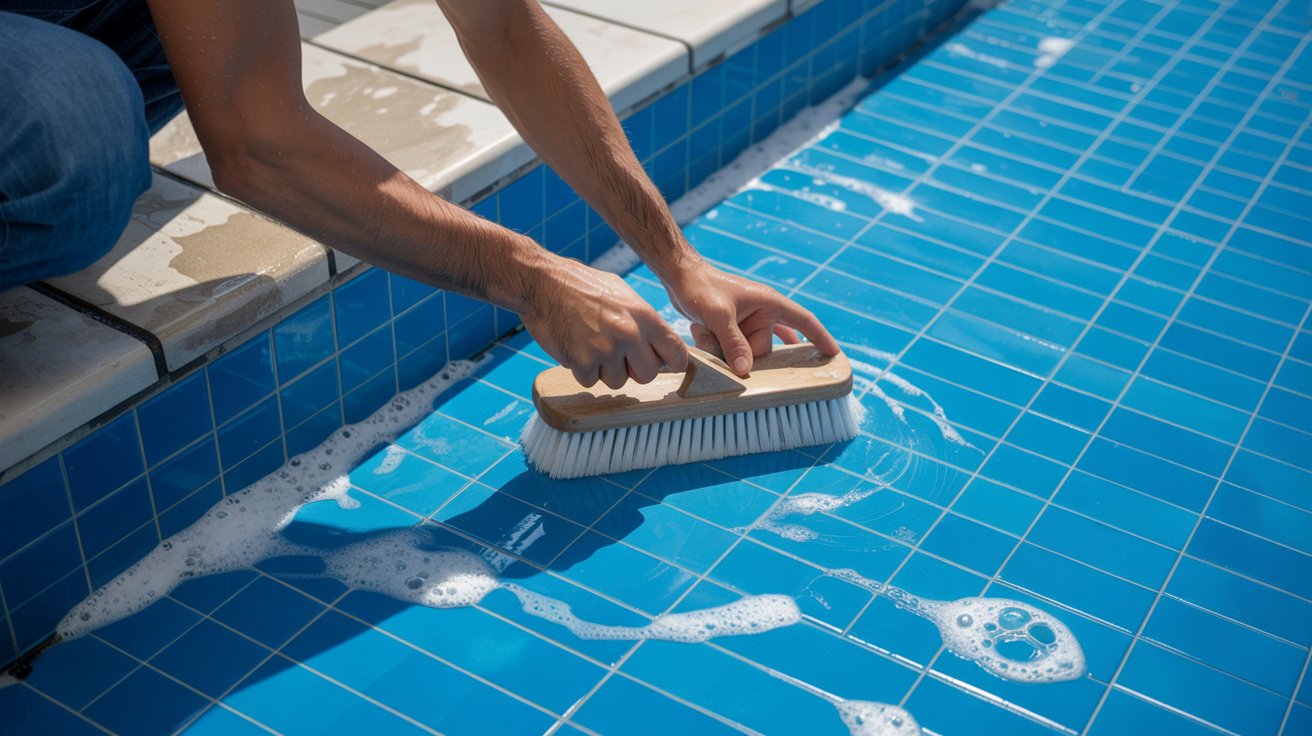
When to Call a Professional
If stains remain after cleaning or if you notice cracked tiles, professional service may be needed. Experts use safe blasting methods that remove scale without damaging the tile surface.
If you need expert assistance with restoring swimming pool tiles’ beauty or maintaining clean surfaces around your pool, SF Marble and Granite offers specialized swimming pool tile services and professional backsplash installation services. These services help keep your pool area in excellent condition while ensuring long-lasting durability and a polished finish.
Conclusion
Knowing how to clean swimming pool tiles helps keep your pool sparkling and safe. Regular brushing, mild cleaning solutions, and proper water chemistry prevent heavy buildup. Whether you want to clean calcium deposits, refresh glass tiles, or brighten grout lines, the right tools and techniques will restore your pool’s shine. Frequent care ensures that stains never become permanent and keeps the pool beautiful throughout the year.
FAQs
How do I make my pool tile look new again?
Scrub the tiles with a mild cleaner, remove calcium deposits, and rinse thoroughly. For heavy buildup, professional soda blasting may restore a like-new appearance.
Can you use vinegar to clean pool tile?
Yes, vinegar mixed with water works well for light scale and general grime.
How to clean pool tile without draining DIY?
Lower the water slightly and scrub the exposed tiles with a brush and cleaning paste.
How often should pool tile be cleaned?
Weekly or monthly cleaning prevents heavy stains and calcium buildup.
What is the best solution to clean pool tiles?
A mixture of baking soda and water works for mild stains. For tough calcium, a commercial cleaner or mild acid solution is effective.
What are the 3 C’s of pool maintenance?
The three C’s are circulation, cleanliness, and chemistry.
Does a magic eraser in the pool pump really clean the pool?
Magic erasers can help remove surface stains, but should not be placed inside pumps.
Why do people put baking soda in their swimming pools?
Baking soda helps raise the alkalinity of the water and prevents corrosion.
How long can a pool go without being cleaned?
A pool should not go more than one to two weeks without cleaning, depending on usage and climate.

